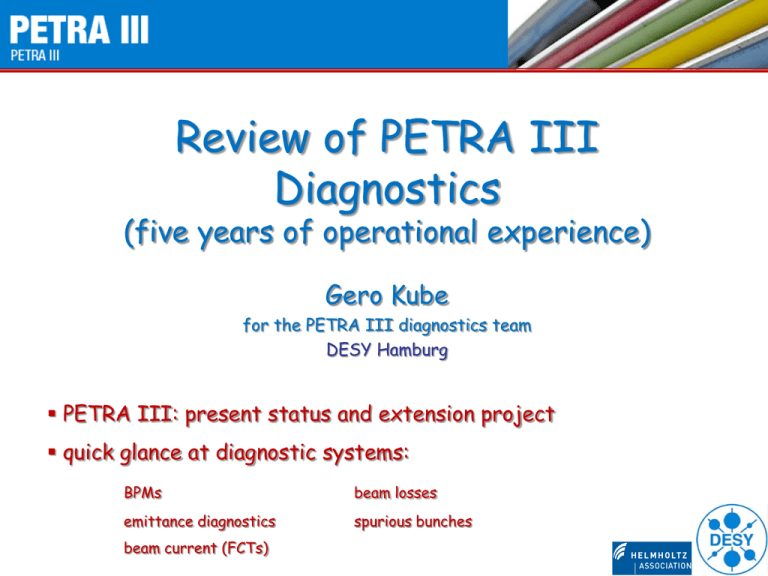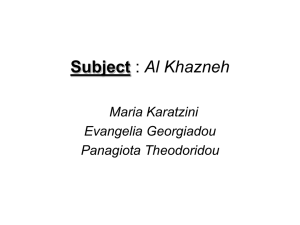Review of PETRA
advertisement

Review of PETRA III Diagnostics (five years of operational experience) Gero Kube for the PETRA III diagnostics team DESY Hamburg PETRA III: present status and extension project quick glance at diagnostic systems: BPMs beam losses emittance diagnostics spurious bunches beam current (FCTs) PETRA III @ DESY DESY site in Hamburg PETRA III parameters circumference: 2304 m energy: 6 GeV emittance: 1 nm.rad emittance coupling : 1% current: 100 mA # bunches: 40 / 960 straight sections: 9 user beamlines: 14 PETRA history 1979 – 1986: undulator length: 2, 5, 10 m e +e - collider (up to 23.3 GeV / beam) 1988 – 2007: pre-accelerator for HERA (p @ 40 GeV, e @12 GeV) since 2009: Gero Kube, DESY / MDI dedicated 3rd generation light source, cost-effective supplement to E-XFEL DEELS 2014 Workshop @ ESRF, 12.05.2014 PETRA Extension P3X motivation DORIS III shutdown in 01/2013 increase number of user beamlines → continuation of successful experiments @ PETRA → 2 new experimental halls,10 new beamlines Gero Kube, DESY / MDI DEELS 2014 Workshop @ ESRF, 12.05.2014 PETRA Extension P3X long PETRA shutdown started 02/2014 construction work in progress back in user operation after about 1 year accelerator modifications about 50m of the storage ring will be modified on either side short dipoles, no sextupoles, space for undulators concrete base instead of girders beam diagnostics copy and paste of existing P3 diagnostics → no time for new developments Gero Kube, DESY / MDI DEELS 2014 Workshop @ ESRF, 12.05.2014 Diagnostics (P3 Design Report) PETRA III: • 228 BPMs → 226 for Orbit → 227 Libera Brilliance • 6 current monitors • 2 Stripline-BPMs and 2 Button-BPMs for Multibunch Feedback • 1 Button-BPM for longitudinal Feedback • 1 Wall Gap Monitor • 1 Laser Wire Scanner • 2 Beamlines for Emittance Diagnostics • 3 Screens Transfer Lines: not sufficient: Gero Kube, DESY / MDI • beam losses • bunch purity • 20 BPMs • 10 Current Monitors • 4 Wall Gap Monitors • 11 Screens DEELS 2014 Workshop @ ESRF, 12.05.2014 BPM System Overview BPM pickups: 8 different pickup types new octant BPM electronics: Libera Brilliance P3 setup old octants → software release 1.87 P3X: upgrade to 2.09 number increases for P3X Gero Kube, DESY / MDI I. Krouptchenkov et al., Proc. DIPAC 2009, Basel, TUPD03, p. 291 DEELS 2014 Workshop @ ESRF, 12.05.2014 BPMs: Operational Experience (1) BPM pickups BPMs between canted undulator cells never used Monitor Profile Position Map 4 → requirement from MAC 25 → design adapted on the rush from APS 15 3 → strong non-linearities Vertical Position [mm] 20 10 mm 5 0 -5 unphysical behaviour from single BPM -10 quasi elliptical shape: 57x7 mm -15 button distance: 9.652 mm -20 → vertical reading not usable button diameter 3.9878 mm 2 1 0 -1 -2 -3 -25 -30 -20 -10 0 → threshold behaviour (single bunch current) 10 20 30 -4 -2 -1.5 mm -1 -0.5 0 0.5 1 1.5 Horizontal Position [mm] → BPM switched off from orbit control 1Bunch2_5mA 1Bunch2mA 100 PSD x [ m /Hz] 40 2 2 PSD x [ m /Hz] 50 30 20 10 0 0 20 40 60 80 100 50 0 120 0 20 40 80 100 120 80 100 120 20 15 2 2 PSD y [ m /Hz] 10 PSD y [ m /Hz] 60 frequency / Hz frequency / Hz 5 0 0 20 40 60 frequency / Hz Gero Kube, DESY / MDI 80 100 120 10 5 0 0 20 40 60 frequency / Hz DEELS 2014 Workshop @ ESRF, 12.05.2014 2 BPMs: Operational Experience (2) BPM electronics in principle Libera Brilliance works fine, but requires some work-arounds digital signal conditioning (DSC) algorithm F. Schmidt-Föhre et al., → switching artefacts in TbT data Proc. DIPAC 2011, Hamburg, TUPD21, p. 350 → sometimes blocked DSC coefficients → learning during strong signal level changes may corrupt coefficients work-around: from time to time DSC auto-learning Gero Kube, DESY / MDI DEELS 2014 Workshop @ ESRF, 12.05.2014 BPMs: Operational Experience (3) BPM electronics (cont.) fast lifetime measurement via BPM sum signal → several BPMs show unstable sum signal → ESRF: temperature and position influence → unstable DSC P3X: improved DSC algorithm with 2.09 upgrade I-Tech: “Angel confirmed that the DSC now works OK at Alba.” failure of 12 V supply power → about 10 times in 5 years, reason not yet understood (and investigated) pile-up from task system → useless cronjob, compromising the performance (work-around: scanning all Liberas, removing by hand) → problem seems to be solved by software updates Gero Kube, DESY / MDI DEELS 2014 Workshop @ ESRF, 12.05.2014 Emittance Diagnostics imaging with Compound Refractive Lens (CRL) optics: X-ray beamline CCD X-ray optics X-ray optics CCD Monochromator Si (311) Monochromator Si (311) design photon energy → ħω = 20 keV vertical resolution broadening → design emittance: εv = 10 pm.rad Gero Kube, DESY / MDI DEELS 2014 Workshop @ ESRF, 12.05.2014 Emittance Diagnostics (2) setup improvements exchange of monochromator crystal improved CRL mounting improved detector setup → measured vertical emittance nearly unaffected assumption photon energy slightly below 20 keV → indication from test measurement before shut-down machine studies: Ultimate Storage Ring natural beam emittance 0 Cq 2 I5 jx I 2 reduction of beam energy: 3 GeV (instead of 6 GeV) → emittance reduction by factor 4 → damping wiggler contribution: εh = 158 pm.rad SR critical energy 3 c c 3 2 Gero Kube, DESY / MDI → SR spectrum by factor 8 X-ray beamline: 20 keV → ħωc = 2.6 keV optical method DEELS 2014 Workshop @ ESRF, 12.05.2014 SR-Interferometer @ PETRA setup in optical hutch magnification lens optical beamline (bunch length diagnostics) GlanThomson polariser lens visible light beampipe double slit mirror boxes bandpass filter & CCD synchrotron light from bending magnet NL 50 alignment mirror vertical design emittance confirmed Gero Kube, DESY / MDI 30 m beam transport via relay optical system DEELS 2014 Workshop @ ESRF, 12.05.2014 SR-Interferometer @ PETRA USR studies confirmation of 3 GeV hor. emittance drawbacks beamline with relay optics → additional uncertainties (lenses) setup blocks Streak camera system → dismount interferometer for bunch length measurement space for only one interferometer → modify setup for measurement in other transverse plane beamline originally not designed for interferometric measurements new optical beamline for P3X construction work in progress → status 6.5.2014 Gero Kube, DESY / MDI DEELS 2014 Workshop @ ESRF, 12.05.2014 In-Flange Fast Current Transformers 3 In-Flange FCTs installed in PETRA 1st damaged after longer operation with 40 bunches @ 1011 particles (80 mA) installation of (provisional) air cooling 2nd damaged after 40 bunch operation in 90 mA 1.5 years later investigation from Bergoz: black residue on flanges inner surface (material seems to be cyanoacrylate impregnating the magnetic cores) outer core wrapping: polyester tape burnt inner core wrapping: fiberglass tape blackened epoxy holding the core in the flanges browned and retracted 50Ω load: one resistor blown one end of the 20‐turn winding desoldered 20‐turn winding inductance 150μH (instead of 4.5mH initially) → relative permeability dropped from about 120000 to 4000 assumption: temperatures of much more than 100°C inside the monitor due to transient losses Gero Kube, DESY / MDI DEELS 2014 Workshop @ ESRF, 12.05.2014 In-Flange FCTs thermal simulations with CST courtesy: D. Lipka (DESY/MDI) high thermal losses in 40 bunch mode → transient effects dominant mode → leaking through FCT gap → power deposition in thermally isolated core temperatures between 100°C and 200°C possible → depending on thermal coupling https://www.cst.com/Applications/Article/Heat-LoadInvestigation-Of-A-PETRA-III-Toroid monitor improvements (Bergoz) replacement of magnet core → material with higher Curie temperature better air cooling of magnet core mechanical modifications → better air circulation installation of temperature sensor → temperature at magnet core Gero Kube, DESY / MDI new monitors installed for P3X DEELS 2014 Workshop @ ESRF, 12.05.2014 Beam Loss Monitoring BLM system originally not planned for PETRA operation in time resolved (40 bunch) mode Touschek limited lifetime → τ ≈ 1.4 h top-up operation observation of radiation damage → rust at undulator magnets → undulator performance degradation → damaged cables installation of HERA BLM system close to IDs monitor → 2 PIN-photodiodes mounted face-to-face coincidence counting: insensitive to synchrotron radiation → up to 10 MHz count rate → dynamic range > 1E8 → 13 years successful operation at HERA Gero Kube, DESY / MDI DEELS 2014 Workshop @ ESRF, 12.05.2014 BLM Experience injected beam losses BLM1 BLM2 circulating beam losses DC current BLM rate reduced Touschek contribution life time Gero Kube, DESY / MDI DEELS 2014 Workshop @ ESRF, 12.05.2014 Loss Contribution observation of beam losses from injected beam dominant loss contribution ??? circulating beam BLM system counting of losses no information about energy deposition BLM system with sensitivity on deposited energy Cherenkov (scintillator) fiber based BLMs test installation at 2 IDs studies with beam → only injection beam losses installation of 1mm thick scintillating fiber observation of losses only from injected beam studies continue after P3X commissioning Gero Kube, DESY / MDI DEELS 2014 Workshop @ ESRF, 12.05.2014 Spurious Bunches trouble-free operation until mid of 2012 suddenly user complaints time resolved mode (40 bunches operation) → nuclear forward scattering experiments with synchrotron radiation (i.e. Mössbauer in time domain) observation of 16 ns time structure in NFS temporal beat pattern courtesy: H.-Ch. Wille (DESY) spurious bunches at 8 ns with 10-7 intensity APD noise up to 20ns ? clean from 20 ns up Gero Kube, DESY / MDI 2 h sample time, sp. bunch rate < 5 Hz, regular with 16ns distance prompt at t = 0 ns measured only for fraction of a second detector noise < 0.1 Hz DEELS 2014 Workshop @ ESRF, 12.05.2014 Spurious Bunches decision to build user independent spurious bunch monitor free port behind monochromator of X-ray diagnostic beamline X-ray Avalanche Photo Diode → dirty surrounding in tunnel → background due to X-ray fluorescence APD detector monochromator chamber γ diffuse scatterer monitor extensively used for studies spurious bunches due to timing issues in injector chain → users are happy with present situation monitor suffers from dirty surrounding optimization still ongoing → so far only qualitative measurements of bunch purity level Gero Kube, DESY / MDI DEELS 2014 Workshop @ ESRF, 12.05.2014 Summary and Outlook status of PETRA III and PETRA III extension project operation of PETRA III diagnostics in general stable and reliable some faulty devices → FCTs → BPMs (pickup and Liberas) for some tasks work-arounds required Libera DSC coefficients diagnostics as planned in PETRA design report was not sufficient optical diagnostics beamline spurious bunches BLMs → hot topic: degradation of IDs commissioning of P3X with additional and improved diagnostics is waiting many thanks …. to all colleagues from the P3 diagnostics team especially to M.Bieler, R.Neumann, D. Nölle, D.Lipka, F.Schmidt-Föhre, H.-Ch. Wille, K.Wittenburg (DESY) J.Bergoz and F.Stulle (Bergoz Instrumentation) and finally special thanks to Kees Scheidt, Philippa Gaget for organizing the workshop Gero Kube, DESY / MDI DEELS 2014 Workshop @ ESRF, 12.05.2014








